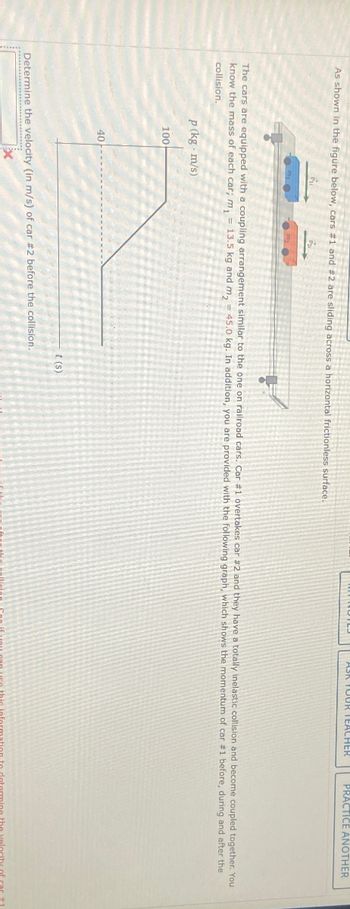
Elements Of Electromagnetics
7th Edition
ISBN: 9780190698614
Author: Sadiku, Matthew N. O.
Publisher: Oxford University Press
expand_more
expand_more
format_list_bulleted
Concept explainers
Question

Transcribed Image Text:ASK TOUR TEACHER
PRACTICE ANOTHER
As shown in the figure below, cars #1 and #2 are sliding across a horizontal frictionless surface.
The cars are equipped with a coupling arrangement similar to the one on railroad cars. Car #1 overtakes car #2 and they have a totally inelastic collision and become coupled together. You
know the mass of each car; m₁ = 13.5 kg and m₂ = 45.0 kg. In addition, you are provided with the following graph, which shows the momentum of car #1 before, during and after the
collision.
p (kg. m/s)
100
40
Determine the velocity (in m/s) of car #2 before the collision.
t(s)
Expert Solution
This question has been solved!
Explore an expertly crafted, step-by-step solution for a thorough understanding of key concepts.
Step by stepSolved in 3 steps with 5 images

Knowledge Booster
Learn more about
Need a deep-dive on the concept behind this application? Look no further. Learn more about this topic, mechanical-engineering and related others by exploring similar questions and additional content below.Similar questions
- You place a 0.18-kg sonic ranger on a low-friction track in front of a 0.50-kg cart to measure the cart's velocity in the Earth reference frame, which turns out to be +(1.0 m/s). You are distracted, the cart hits the ranger in a totally inelastic collision, and the two objects then move forward together. A friend is running toward the cart with a velocity of -(3.5 m/s) with her sonic ranger on and pointed at the cart. ▾ Part A What is the x-component of the momentum of the cart with the ranger stuck to it, in your friend's reference frame?arrow_forwardA 10kg object is dropped from rest from the top of a 100m cliff. Exactly one second later, an 8g bullet is fired upward from the ground with a muzzle velocity of 300(m)/(s). Assume an inelastic collision occurs between the two objects. How long after the 10kg object is dropped will the combined object hit the ground? Compare that time to the time for the 10kg object to hit the ground without the collision.arrow_forwardcan you pls also draw a picture/representation of the scenario described? Thanks so much!arrow_forward
- Please answer quick you are in a bumper car with a total mass of 200.0kg your friend is also in a bumper car with a total mass of 200.0kg.You are moving to the right at 1.00m/s. Your friend is moving to the left at 0.500m/s. Your car hits a spot on your friends car that has no bumper. Your bumper acts as a spring with a spring constant of 2.00x10^4N/m. Determine the velocity of your car when the bumper has raced a maximum compression of 0.0700m.Assume friction is negligible.arrow_forwardgraduate who joined the Navy as a pilot is about to take off in an F-15 (WF15 = 81,000 lb) from an aircraft carrier traveling at VA = 40 mph. The jet is launched from the catapult system (a connection just below the deck that assists the aircraft) with the force (Fcp) vs time curve shown that has points of F₁ = 1,000 lb at t₁ = 2 s and F₂ = 3,000 lb at t₂ = 5 s (the plane will reach the edge of the deck at t₂). The F-15 needs to be traveling at 170 mph to take off. Determine how much constant thrust (FTR) the engines must produce during the launch to reach this speed. F2 F₁ FCP t₁ VA t₂ FTR t (s)arrow_forwardUsing the general Lagrange equation, write the model for the elevator shown. Sketch the block simulation diagram.arrow_forward
arrow_back_ios
arrow_forward_ios
Recommended textbooks for you
 Elements Of ElectromagneticsMechanical EngineeringISBN:9780190698614Author:Sadiku, Matthew N. O.Publisher:Oxford University Press
Elements Of ElectromagneticsMechanical EngineeringISBN:9780190698614Author:Sadiku, Matthew N. O.Publisher:Oxford University Press Mechanics of Materials (10th Edition)Mechanical EngineeringISBN:9780134319650Author:Russell C. HibbelerPublisher:PEARSON
Mechanics of Materials (10th Edition)Mechanical EngineeringISBN:9780134319650Author:Russell C. HibbelerPublisher:PEARSON Thermodynamics: An Engineering ApproachMechanical EngineeringISBN:9781259822674Author:Yunus A. Cengel Dr., Michael A. BolesPublisher:McGraw-Hill Education
Thermodynamics: An Engineering ApproachMechanical EngineeringISBN:9781259822674Author:Yunus A. Cengel Dr., Michael A. BolesPublisher:McGraw-Hill Education Control Systems EngineeringMechanical EngineeringISBN:9781118170519Author:Norman S. NisePublisher:WILEY
Control Systems EngineeringMechanical EngineeringISBN:9781118170519Author:Norman S. NisePublisher:WILEY Mechanics of Materials (MindTap Course List)Mechanical EngineeringISBN:9781337093347Author:Barry J. Goodno, James M. GerePublisher:Cengage Learning
Mechanics of Materials (MindTap Course List)Mechanical EngineeringISBN:9781337093347Author:Barry J. Goodno, James M. GerePublisher:Cengage Learning Engineering Mechanics: StaticsMechanical EngineeringISBN:9781118807330Author:James L. Meriam, L. G. Kraige, J. N. BoltonPublisher:WILEY
Engineering Mechanics: StaticsMechanical EngineeringISBN:9781118807330Author:James L. Meriam, L. G. Kraige, J. N. BoltonPublisher:WILEY

Elements Of Electromagnetics
Mechanical Engineering
ISBN:9780190698614
Author:Sadiku, Matthew N. O.
Publisher:Oxford University Press

Mechanics of Materials (10th Edition)
Mechanical Engineering
ISBN:9780134319650
Author:Russell C. Hibbeler
Publisher:PEARSON

Thermodynamics: An Engineering Approach
Mechanical Engineering
ISBN:9781259822674
Author:Yunus A. Cengel Dr., Michael A. Boles
Publisher:McGraw-Hill Education

Control Systems Engineering
Mechanical Engineering
ISBN:9781118170519
Author:Norman S. Nise
Publisher:WILEY

Mechanics of Materials (MindTap Course List)
Mechanical Engineering
ISBN:9781337093347
Author:Barry J. Goodno, James M. Gere
Publisher:Cengage Learning

Engineering Mechanics: Statics
Mechanical Engineering
ISBN:9781118807330
Author:James L. Meriam, L. G. Kraige, J. N. Bolton
Publisher:WILEY